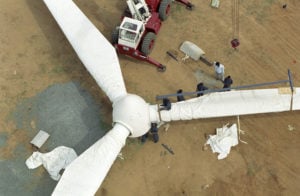The diplomatic pressure on India to set a cut-off date to reach net-zero greenhouse gas (GHG) emissions has intensified, after US President Joe Biden invited Prime Minister Narendra Modi to a virtual “Leaders Summit on Climate”. The invitation has triggered a public debate in India, with one politician from the ruling party criticising the country’s official position that no target will be announced at present.
China, the US and the EU (which counts its emissions as a bloc) – the world’s top three GHG polluters – are among 58 that have declared a year by which they will no longer add to heat-trapping emissions. India is fourth on the list of polluters.
Biden’s special climate envoy John Kerry has indicated that he expects all 40 countries attending the April 22-23 summit to declare net-zero targets, as has the UK, which will host the next round of UN climate talks.
The pressure will grow further later in the year, when the Intergovernmental Panel on Climate Change (IPCC) starts to release its next assessment report part by part. Scientists and policy analysts working on the drafts say climate change is intensifying and is already affecting people and economies around the world.
The UN Environment Programme has reported a major gap between countries’ emission-control plans and their vow under the Paris Agreement to keep average global temperature rise “well below” two degrees Celsius. This has increased pressure on governments to raise their ambitions and declare a net-zero target year.
For and against
Despite these developments, most Indian policymakers and think tanks are still against the idea of a net-zero target for India, in line with the country’s long-held negotiating position under the UN Framework Convention on Climate Change (UNFCCC). Just a few weeks ago, the environment minister Prakash Javadekar reiterated that India should focus on development as well as on its climate commitments, and former Indian climate negotiators echoed the same sentiment.
But Jayant Sinha, former minister and MP in the ruling Bharatiya Janata Party, has said that declaring 2050 as the net-zero year would make the country “hypercompetitive” in the coming decades.
The roadmaps
While the fast fossil fuel phasedown involved in meeting a net-zero target has many advantages for air pollution and public health among others, the downsides are considerable. Moving away from coal, which still accounts for most of India’s energy mix, would put millions out of work and would risk bankrupting Indian Railways, which relies on coal transportation for a substantial share of its revenue. Few analysts think such a step can be achieved quickly.
Outside government, Navroz Dubash, professor at Indian think tank the Centre for Policy Research, has argued that a net-zero pledge would disrupt India’s economy, and not for the better.
Speaking at an event, Dubash – who is a lead IPCC author – said India must announce and implement immediate climate actions rather than make net-zero declarations that may contain little substance. Long-term pledges should form the support rather than the centre of India’s climate moves, he added.
Long-term pledges should form the support rather than the centre of India’s climate moves
Many immediate actions are both doable and necessary. Energy and land-use change currently account for 88% of India’s emissions. Stopping deforestation should be a priority now. In the energy sector, the problem today is not a lack of renewable capacity, but the inability of the distribution system to carry electricity. India is also failing to promote rooftop solar, which could be encouraged through a metering system allowing consumers to sell their excess energy back to the grid.
Still, some Indian think tanks believe that looking at roadmaps to a hypothetical net-zero target is a worthy exercise.
73% to 5%
Fall in share of coal, oil and gas in India’s primary energy mix if it is to reach net-zero emissions by 2050
The Council on Energy, Environment and Water (CEEW), a think tank, has analysed various ‘peaking’ and ‘net-zero’ year combinations for India’s GHG emissions, starting with 2030 as the peak year (when emissions reach their highest point before starting to decrease). It points out that for net-zero emissions to be achieved by 2050, the share of coal, oil and gas in India’s primary energy mix will have to fall from 73% in 2015 to 5% in 2050. It still recommends early peaking and net zero year pledges, on the argument that leaving it late will cost more.
The Energy and Resources Institute (TERI), another think tank, has worked with oil major Shell on a set of prescriptions for India to reach net zero by 2050. They stress the importance of energy efficiency, assume a big role for hydrogen fuel from the 2030s and recommend artificial removal of GHG from the air through methods known generically as carbon capture and storage.
Such a quick transition would also mean some unpopular decisions. Vaibhav Chaturvedi, an economist and fellow at CEEW, cautioned that household electricity prices and railway fares would increase; coal-dependent states would face fiscal challenges; and half a million mining jobs would be lost. “There will be lots of assets built for the old [fossil fuel-based] economy that would be left stranded,” he said.
Still, he added, “India should not wait until 2050 to peak its emissions. Postponing peaking and the consequent net-zero deadline will increase India’s climate impact, which needs to be minimised.”
Analysts believe that most big economies that have declared net-zero years have already worked out roadmaps, but have not made them public. Dave Elliott, who teaches technology policy at the Open University in the United Kingdom, thinks this is because rich nations want to use an emission accounting strategy known as carbon offset schemes, and are waiting to see if the market for this takes off.
Carbon offset schemes rely on developing countries reducing their emissions first, and then ‘selling’ part of such reductions in the form of carbon credits to developed countries. The efficacy of this plan will depend on the per-tonne price of carbon emissions traded on financial markets. The price is currently so low it leaves little incentive for developing countries to participate.
What price old promises?
While the net-zero debate goes on, Indian government negotiators are preparing to quiz rich nations on old promises – made since 1997, repeated often, and broken more often still. At the 2015 Paris climate summit, it was decided that the Paris Agreement would come into force in 2020, while all nations made pledges on what they would do before 2020.
The UN has scheduled a ‘stocktake’ of countries’ Paris pledges for 2023, and India’s environment and climate change ministry has now asked a think tank (which does not wish to be identified) to work out how many of these ‘pre-2020 commitments’ have been fulfilled.
An official in India’s energy ministry said, “That will be the time to see how all countries have fared since they signed the Paris Agreement in 2015, and what more may be necessary, by whom.”
It’s very easy to make a promise you don’t have to live up to.Indian government negotiator
An interim report by the think tank showed the United Kingdom topping the list of countries that are fulfilling their commitments. The EU member countries come second. But no developed country outside Europe appears to be keeping its promises. An Indian government negotiator asked in response, “Why should we trust the developed countries when they keep breaking their word? Many of us think all these net-zero declarations are merely to push the goalposts back. Nobody in power today will be in charge of keeping these promises in 2050 or later. It’s very easy to make a promise you don’t have to live up to.”


![Indians wearing protective masks stand with their luggage in queue outside a railway station [image: Alamy]](https://dialogue.earth/content/uploads/2020/05/indians-protective-masks-300x200.jpg)






